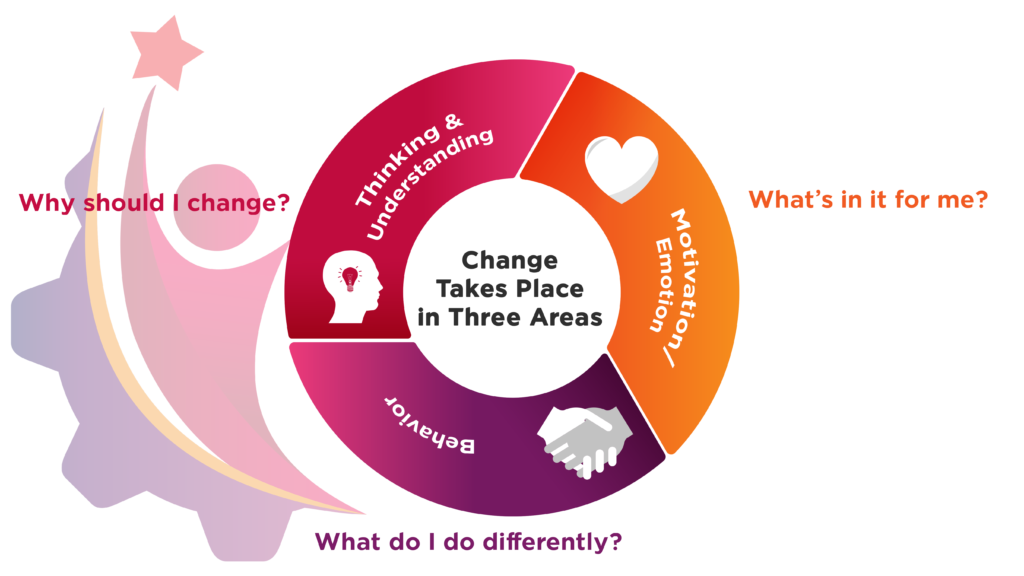Cushion your employees, in case of change!
People often associate change with fight or flight responses. As a company, we don’t want either of them, as they can disrupt the processes and affect the efficiency of the company. Hence, we need to make sure that people divert from resisting change to embracing their new work environment.
It is true that sometimes, a change happens in a work environment has a much greater effect on the company than on the people. Imagine a company going through a merger and all those legal, financial and structural changes that you’ll have to go through. But managing the people side of change is often the most challenging and critical component of an organizational transformation.
Head to heart to hand method is one of the most famous techniques to handle such changes in a company. It is as follows,
- Head: This refers to the logic of the analysis and recommendation, which your brain needs to work with. The company owners should always see the big picture while setting priorities. Constant change makes it harder to commit to a future but strategic thinking may lead the organization in the right direction. Hence, updating and integrating strategic changes into the operating model of the organization on an ongoing basis is crucial.
- Heart: We’ve decided that constant updates on transformation are crucial, but sometimes we leave behind the fact that successful transformation lies in the hands of people who are ready to go above and beyond. This can be done by introducing a set of good ‘heart’ practices by the leaders. For example, leaders should inspire and encourage the team by creating an empowering culture that allows them to give their best. They should also care for the lives that are affected during the transformation process. This will enable their team to navigate in the right direction.
- Hand: Executing a prescribed set of actions for bottom-line improvements is out of date. In the new era, the responsibility of transformation is given to leaders at all levels rather than just the company owners, so that they can ensure execution by equipping teams with the resources they need to make the right decisions. Innovative ways and digital tools come in handy when carrying out the process of transformation.
So yes, it’s basically thinking and understanding why I should change, to get emotionally what is in it for me and act accordingly understanding what I should do differently.

Applying this at the workplace:
When following Head – you have to ensure that your staff knows why the change is needed and what made you take that decision. When communicating that to the team, make sure that your explanation fulfills the following:
- provides a sense of significance,
- is grounded on business knowledge,
- is concrete and specific,
- stretches people,
- has a clear destination,
- presents a clear contrast between the current conditions and the preferred future,
- is focused on the medium- to long-term.
When following Heart – Trust and empower people to change and make sure you communicate why they should change.
When following Hand – Finally you have to make sure that the employees embrace change and act accordingly.
Don’t forget to involve employees!
Don’t forget that your employees deserve to know what’s happening around them. They define the company and the success of the company depends on the performance of them, yes you can identify them all as change agents of the company. As long as they feel involved in a change or in the process, they will feel owned and the performance will clearly get impacted.
Okay, let’s put yourself in two situations.
Imagine the owner of the company coming to you and communicating about a change that is about to occur. Now imagine your immediate supervisor adapting the change to himself / herself and directing you towards following him / her.
Which one do you think is more effective?
Yes, involving your employees in the decision making by adapting it accordingly is what is required.
Don’t take big steps, communicate the steps in the change process one at a time!
Do not overload your employees with changes. Them going through a shock is the last thing you want during a process of change. Make sure you leave them space to digest whatever is going on. Try promoting day-to-day examples and tasks for them to follow and you can reward them to increase productivity when meeting with the expected change.
Evaluation is a must!
Keeping a track of how they adapt and the effectiveness of the process is a must. Don’t you think so? This will help you to monitor all their actions and advise them according to their performance. The PDCA cycle will come in handy here.





